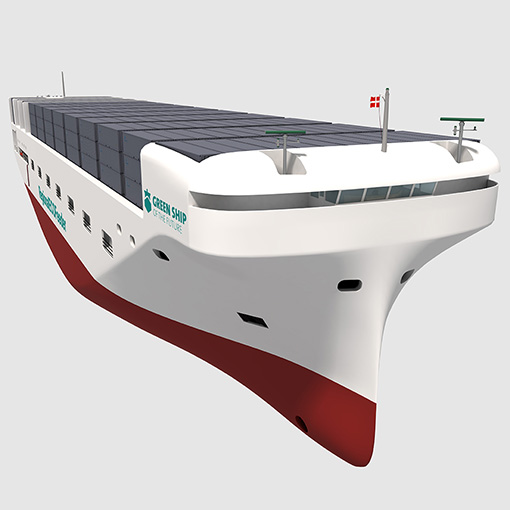IF you want it you can have it, but you may want to wait.
A consortium of leading European designers, suppliers and engineering companies has come together to demonstrate how a new type of feeder container ship could be built today using existing technology and give huge fuel and CO2 savings. There is however just one part that would make it unfeasible today.
The consortium is through the Danish led Greenship of the Future and the argument is that the existing fleet of 1,861 feeder vessels between 1,000 teu and 3,000 teu in size is ageing. Over 50% of them are over ten years old and 18% are over 20 years old. Therefore they have designed the RegionalECOfeeder.
The project was driven by Odense Maritime Technology, a company that grew out of the former Odense Shipyard in Denmark, best known in recent years for delivering container vessels for its then parent, Maersk.
The claim is the vessel the companies have drawn up could save 30% of the fuel and CO2 emissions per transported container compared to the world fleet average.
The consortium says that significant savings can be achieved not only by bolting on existing technologies, but by looking at optimal interactions, so the design suggests an open top concept for the vessel with cell guides rather than traditional lashings, to make port turnaround much quicker. Vacuum mooring systems would be deployed, as this would remove the need for larger crews to perform time consuming, and often dangerous, rope-based mooring operations.
The vessel would have a wider beam than a similar feeder vessel of its size, but a beam maximised for the Kiel Canal at 32.5 m. The design would reduce ballast water requirements, and ballast tank requirements would be met with much slimmer tanks than generally seen today.
A teasing wait?
The one part of the design which makes the vessel unfeasible currently is the proposal to combine navigation, control room and offices in a smaller lower accommodation block with contravenes existing rules on navigation and look outs.
The team behind this want to use a virtual bridge complete with CCTV camera and sensors, with a forward auxiliary wheelhouse for use in congested calm waters.
The project clearly takes a leaf out of the proposals that have been put forward by some technology companies like Rolls Royce, one of the project partners, that want to see autonomous ships on the water.
Included in the design is a two stroke dual fuel engines and four LNG tankers with a 1,300 m3 capacity, an inline shaft generator and two diesel generators to create power, along with a battery pack to reduce generator load peak. Other considerations to make the vessel fuel efficient include waste heat recovery system, air lubrication to reduce water drag, twisted leading edge rudder with bulb, and a large curve-bladed Kappel propeller.
While the navigation part of the proposal remains unfeasible, the other parts of the project are all available, and can be deployed into a feeder design today which means that as the current feeder fleet needs replacing, it can demonstrate a move towards meeting shipping’s CO2 commitments.
Companies in the Green ship of the Future’s RegionalECOFeeder project, which is backed by the Danish Maritime Fund are:
AAB, Alfa Laval, Bureau Veritas, Corvus Energy, Danfoss VLT Drivers, Danish Maritime, DNV GL, DTU Mechanical Engineering, HOK Marineconsult, Lloyd’s Register, MAN Diesel & Turbo, Odense Maritime Technology, Rolls Royce Marine, Silverstream Technologies, VP Solutions.
Fathom-news
editor@fathom-mi.com
































